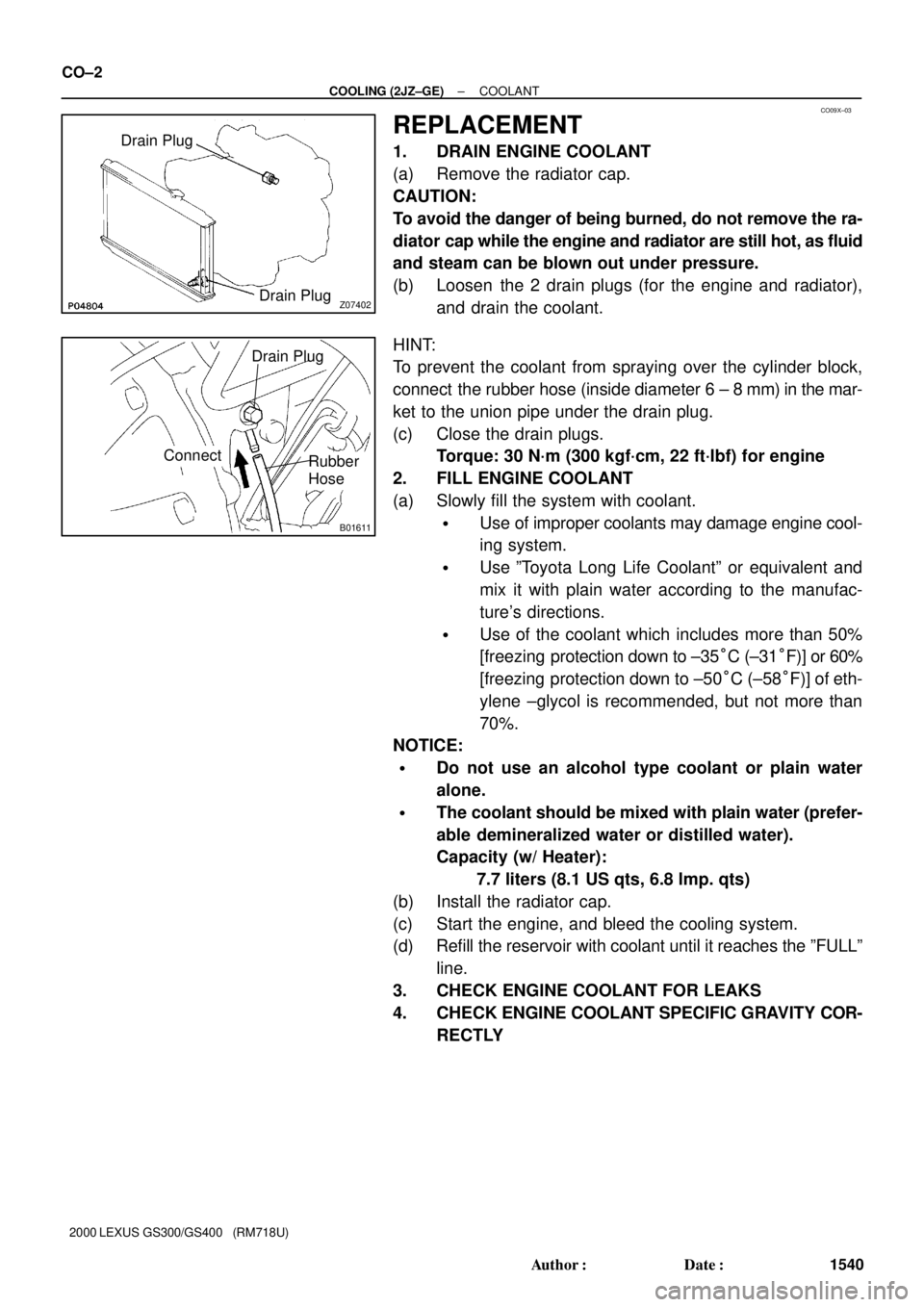Page 459 of 1111
CH045±01
B02027
Turn
B01646
B01962
Engine
Wire Clamp
Pipe Clamp
B01963
Pipe Bracket
CH±6
± CHARGING (2JZ±GE)GENERATOR
1608 Author�: Date�:
2000 LEXUS GS300/GS400 (RM718U)
REMOVAL
1. REMOVE ENGINE UNDER COVER
2. REMOVE DRIVE BELT
Loosen the belt tension by turning the drive belt tensioner clock-
wise, and remove the drive belt.
NOTICE:
At the time of installation, please refer to the following
items. Do an on±vehicle inspection. (See page CH±1)
3. REMOVE GENERATOR
(a) Disconnect the generator connector.
(b) Remove the rubber cap and nut, and disconnect the gen-
erator wire.
(c) Disconnect the engine wire clamp from the wire clip on the
generator.
(d) Remove the bolt and pipe clamp, and disconnect the 2
A/T oil cooler pipes from the generator.
(e) Remove the bolt, nut, pipe bracket and generator.
Torque: 40 N´m (400 kgf´cm, 30 ft´lbf)
Page 464 of 1111
CO09W±03
± COOLING (2JZ±GE)COOLANT
CO±1
1539 Author�: Date�:
2000 LEXUS GS300/GS400 (RM718U)
COOLANT
INSPECTION
1. CHECK ENGINE COOLANT LEVEL AT RESERVOIR
The engine coolant level should be between the ºLOWº and ºFULLº lines, when the engine is cold.
If low, check for leaks and add ºToyota Long Life Coolantº or equivalent up to the ºFULLº line.
2. CHECK ENGINE COOLANT QUALITY
There should not be any excessive deposits of rust or scale around the radiator cap or radiator filler hole,
and the coolant should be free from oil.
If excessively dirty, replace the coolant.
Page 466 of 1111
CO0A3±01
B01940
± COOLING (2JZ±GE)THERMOSTAT
CO±11
1549 Author�: Date�:
2000 LEXUS GS300/GS400 (RM718U)
REMOVAL
HINT:
Removal of the thermostat would have an adverse effect, caus-
ing a lowering of cooling efficiency. Do not remove the thermo-
stat, even if the engine tends to overheat.
1. DRAIN ENGINE COOLANT
2. DISCONNECT WATER INLET FROM WATER PUMP,
AND REMOVE THERMOSTAT
(a) Remove the 2 nuts holding the water inlet to the water
pump, and disconnect the water inlet from the water
pump.
(b) Remove the thermostat.
(c) Remove the gasket from the thermostat.
Page 468 of 1111
CO0A5±01
P 1111 7
ProtrusionJiggle Valve
± COOLING (2JZ±GE)THERMOSTAT
CO±13
1551 Author�: Date�:
2000 LEXUS GS300/GS400 (RM718U)
INSTALLATION
1. PLACE THERMOSTAT IN WATER INLET
(a) Install a new gasket to the thermostat.
(b) Align the jiggle valve of the thermostat with the protrusion
of the water inlet.
2. INSTALL WATER INLET
Install the water inlet with the 2 nuts.
Torque: 9.0 N´m (90 kgf´cm, 80 in.´lbf)
3. FILL WITH ENGINE COOLANT
4. START ENGINE AND CHECK FOR COOLANT LEAKS
Page 470 of 1111

CO0A7±01
CO1242
Radiator Cap Tester
Radiator Cap
30° or More
B01882
Radiator Cap Tester
± COOLING (2JZ±GE)RADIATOR
CO±15
1553 Author�: Date�:
2000 LEXUS GS300/GS400 (RM718U)
ON±VEHICLE INSPECTION
1. REMOVE RADIATOR CAP
Remove the radiator cap from the radiator.
CAUTION:
To avoid the danger of being burned, do not remove the ra-
diator cap while the engine and radiator are still hot, as fluid
and steam can be blown out under pressure.
2. INSPECT RADIATOR CAP
NOTICE:
�If the radiator cap has contaminations, always rinse
it with water.
�Before using a radiator cap tester, wet the relief valve
and pressure valve with engine coolant or water.
�When performing steps (a) and (b) below, keep the
tester at an angle of over 30° above the horizontal.
(a) Using a radiator cap tester, slowly pump the tester and
check that air is coming from the vacuum valve.
Pump speed: 1 push/(3 seconds or more)
NOTICE:
Push the pump at a constant speed.
If air is not coming from the vacuum valve, replace the radiator
cap.
(b) Pump the radiator cap tester, and measure the relief valve
opening pressure.
Pump speed: 1 push within 1 second
NOTICE:
This pump speed is for the first pump only (in order to close
the vacuum valve). After this, the pump speed can be re-
duced.
Standard opening pressure:
93 ± 123 kPa (0.95 ± 1.25 kgf/cm
2, 13.5 ± 17.8 psi)
Minimum opening pressure:
78 kPa (0.8 kgf/cm
2, 11.4 psi)
HINT:
Use the tester's maximum reading as the opening pressure.
If the opening pressure is less than minimum, replace the radia-
tor cap.
3. INSPECT COOLING SYSTEM FOR LEAKS
(a) Fill the radiator with coolant and attach a radiator cap tes-
ter.
(b) Warm up the engine.
(c) Pump it to 118 kPa (1.2 kgf/cm
2, 17.1 psi), and check that
the pressure does not drop.
If the pressure drops, check the hoses, radiator or water pump
for leaks. If no external leaks are found, check the heater core,
cylinder block and head.
4. REINSTALL RADIATOR CAP
Page 471 of 1111
CO0A8±01
B02029
Air Cleaner Inlet
Upper Radiator Support
Air Cleaner and MAF
Meter Assembly
Lower Radiator Support
Intake Air Resonator
Engine Under Cover
x 18
ECT Switch
Connector for
Electric Cooling
Fan Lower Radiator Hose
Upper Radiator Support
Upper Radiator Hose
ECM Outlet Duct
Wire Clamp
Electric Cooling
Fan Connector
Oil Cooler Hose
for A/T Engine Wire
Clamp MAF Meter Connector
Radiator and Electric
Cooling Fan Assembly
EVAP Hose
CO±16
± COOLING (2JZ±GE)RADIATOR
1554 Author�: Date�:
2000 LEXUS GS300/GS400 (RM718U)
COMPONENTS
Page 473 of 1111

CO0A9±03
B01881
CO±18
± COOLING (2JZ±GE)RADIATOR
1556 Author�: Date�:
2000 LEXUS GS300/GS400 (RM718U)
REMOVAL
1. REMOVE ENGINE UNDER COVER
2. DRAIN ENGINE COOLANT
3. REMOVE AIR CLEANER INLET
4. REMOVE AIR CLEANER AND MAF METER AS-
SEMBLY
5. REMOVE RADIATOR AND ELECTRIC COOLING FAN
ASSEMBLY
(a) Disconnect the upper radiator hose from the radiator.
(b) Disconnect the lower radiator hose from the radiator.
(c) Disconnect the ECM outlet duct from the ECM box.
(d) Disconnect the wire for electric cooling fan from the clamp
on the electric cooling fan.
(e) Disconnect the 2 electric cooling fan connectors.
(f) Disconnect the ECT switch connector for electric cooling
fan.
(g) Disconnect the 2 oil cooler hoses for A/T from the radiator.
(h) Remove the 2 nuts and 2 upper radiator supports.
(i) Lift out the radiator and cooling fan assembly.
(j) Remove the 2 lower radiator supports.
6. REMOVE ELECTRIC COOLING FAN FROM RADIA-
TOR
(a) Disconnect the radiator reservoir hose from the radiator.
(b) Remove the 6 bolts and electric cooling fan.
Page 475 of 1111

CO09X±03
Z07402
Drain Plug
Drain Plug
B01611
Drain Plug
Rubber
HoseConnect
CO±2
± COOLING (2JZ±GE)COOLANT
1540 Author�: Date�:
2000 LEXUS GS300/GS400 (RM718U)
REPLACEMENT
1. DRAIN ENGINE COOLANT
(a) Remove the radiator cap.
CAUTION:
To avoid the danger of being burned, do not remove the ra-
diator cap while the engine and radiator are still hot, as fluid
and steam can be blown out under pressure.
(b) Loosen the 2 drain plugs (for the engine and radiator),
and drain the coolant.
HINT:
To prevent the coolant from spraying over the cylinder block,
connect the rubber hose (inside diameter 6 ± 8 mm) in the mar-
ket to the union pipe under the drain plug.
(c) Close the drain plugs.
Torque: 30 N´m (300 kgf´cm, 22 ft´lbf) for engine
2. FILL ENGINE COOLANT
(a) Slowly fill the system with coolant.
�Use of improper coolants may damage engine cool-
ing system.
�Use ºToyota Long Life Coolantº or equivalent and
mix it with plain water according to the manufac-
ture's directions.
�Use of the coolant which includes more than 50%
[freezing protection down to ±35°C (±31°F)] or 60%
[freezing protection down to ±50°C (±58°F)] of eth-
ylene ±glycol is recommended, but not more than
70%.
NOTICE:
�Do not use an alcohol type coolant or plain water
alone.
�The coolant should be mixed with plain water (prefer-
able demineralized water or distilled water).
Capacity (w/ Heater):
7.7 liters (8.1 US qts, 6.8 lmp. qts)
(b) Install the radiator cap.
(c) Start the engine, and bleed the cooling system.
(d) Refill the reservoir with coolant until it reaches the ºFULLº
line.
3. CHECK ENGINE COOLANT FOR LEAKS
4. CHECK ENGINE COOLANT SPECIFIC GRAVITY COR-
RECTLY